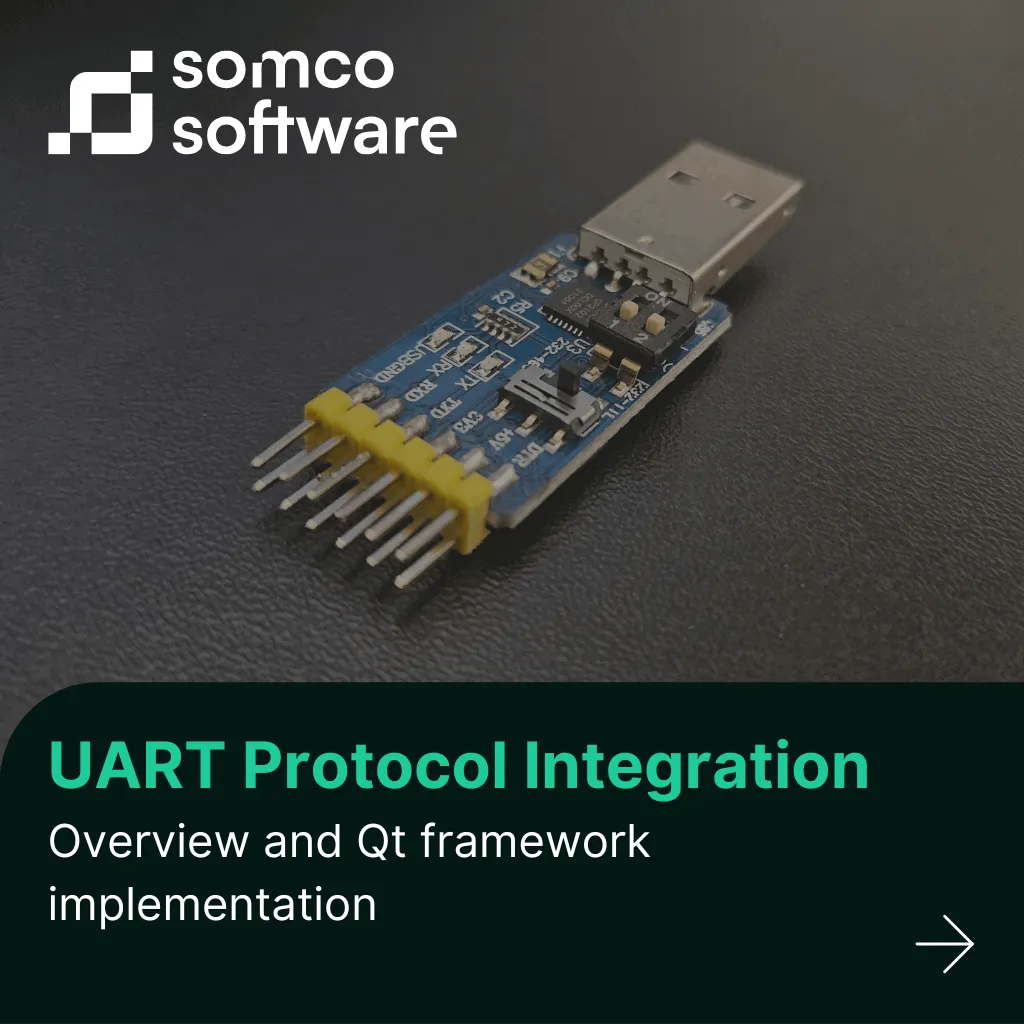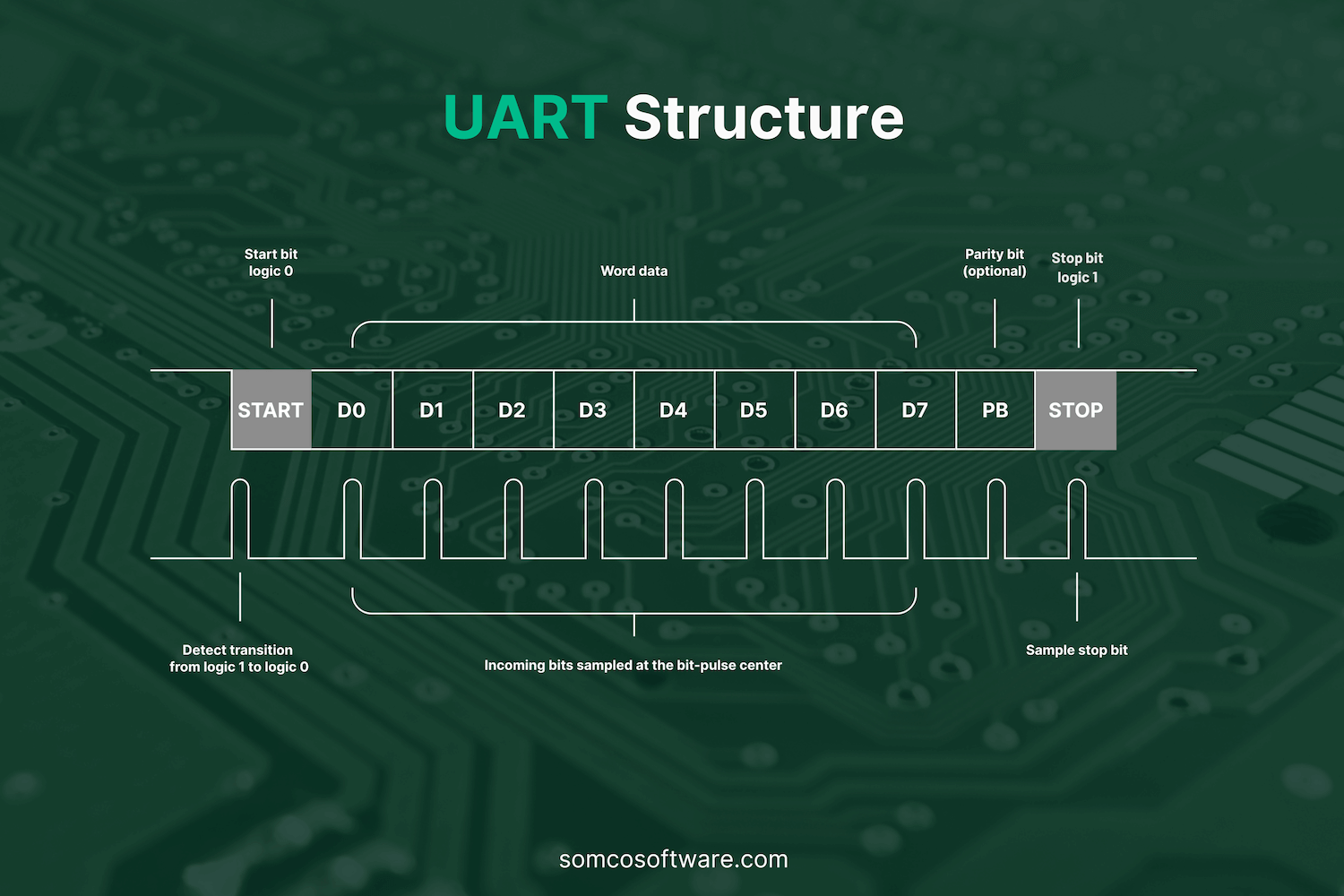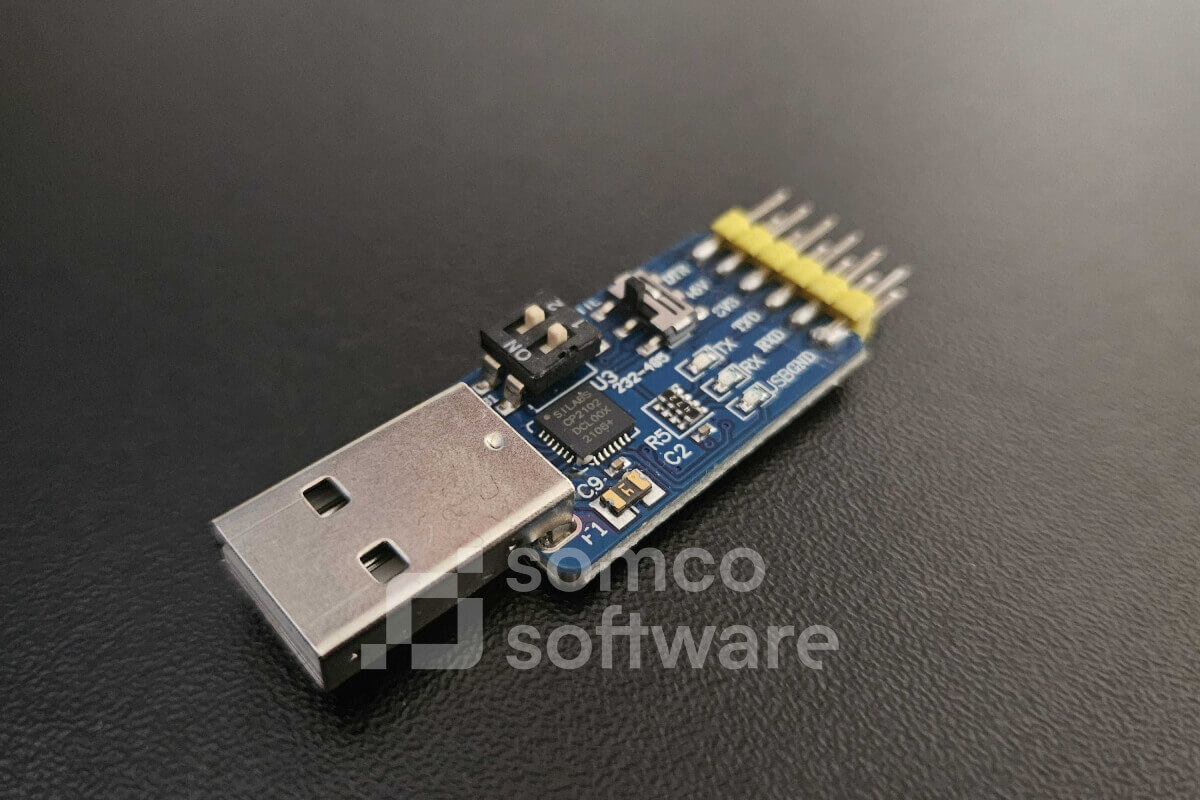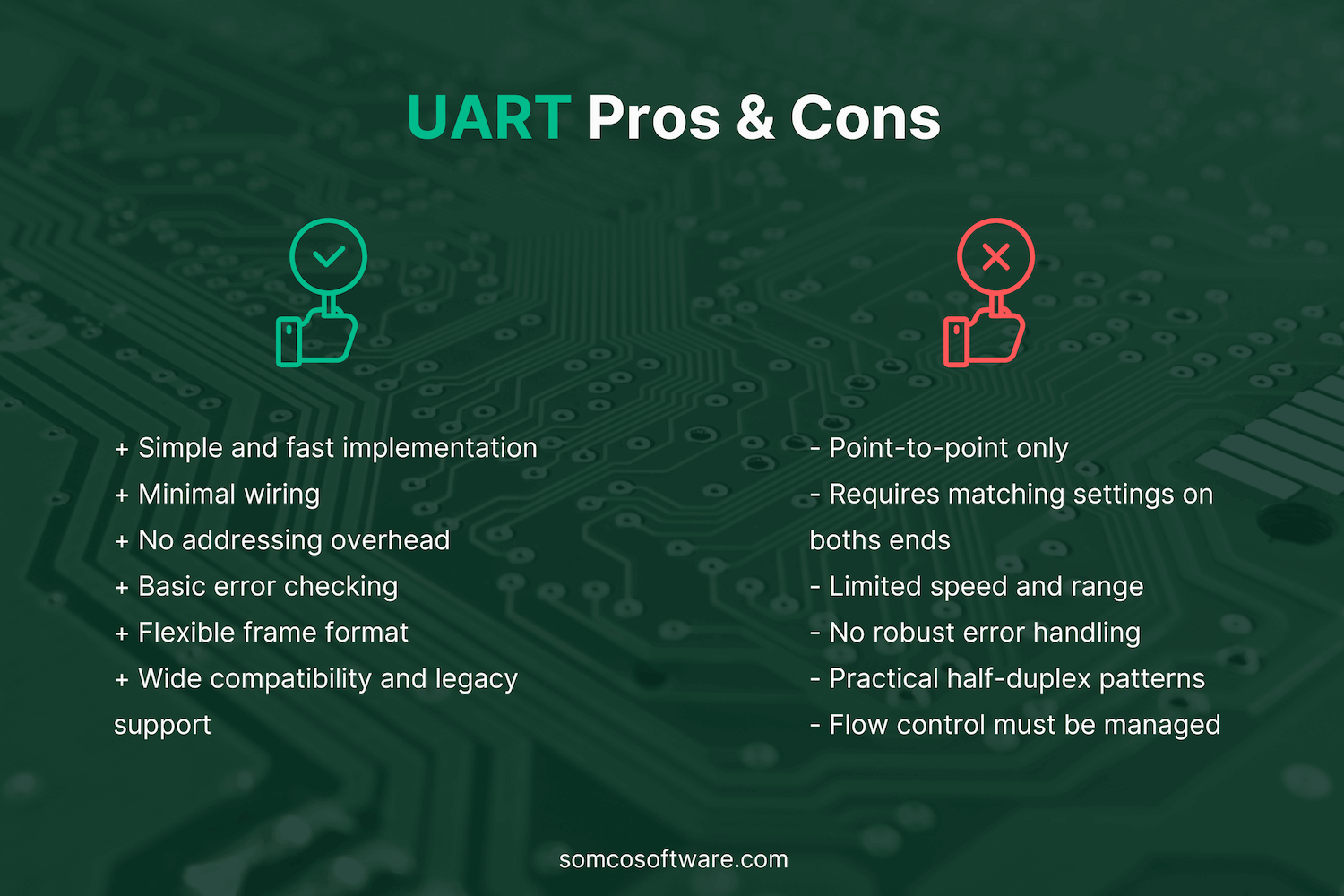
Rust vs C++: Successor or Pretender? Honest Opinion of our CTO
As systems grow more complex and reliability becomes mission-critical, developers face an old but still unsolved dilemma: should you build […]

Reliable device-to-device communication is at the heart of every well-designed embedded system. Whether you’re building a sensor gateway, configuring industrial hardware, or debugging a safety-critical medical device, having a robust and predictable hardware communication protocol is essential.
UART remains one of the most widely used serial communication protocols in embedded systems — not because it’s the newest, but because it’s simple, efficient, and well-supported across virtually all hardware platforms. In fact, it’s considered one of the earliest serial protocols still in common use today.
In this article, we’ll explore:
Need support implementing UART-based protocols or developing embedded system software?
Let’s talk about how we can support your team.
UART (Universal Asynchronous Receiver/Transmitter) is one of the simplest and oldest serial communication protocols in the embedded systems – in full form often referred to as an asynchronous receiver transmitter UART. It enables two electronic devices to exchange serial data over just two wires: a transmit line (TX) and a receive line (RX) – commonly known as the UART data transmission line.
Unlike synchronous protocols (e.g. SPI or I²C), UART is asynchronous communication – there is no shared internal clock signal between the devices. Instead, each UART transmitter and receiver must agree on a data rate (transmission speed) and framing format in advance. Every data frame is wrapped with special bits (start and stop bits, and optionally an even parity bit matches rule) so the receiver can synchronize to the sender’s timing on the fly. The arrangement of these elements defines the overall data format and ensures each data packet is interpreted correctly. This start-stop framing allows UART devices to send data at arbitrary intervals without an external clock, hence “asynchronous.”
In practice, a UART link is typically point-to-point: it connects two devices directly, such as a microcontroller and a PC, or an MCU and a peripheral module, often referred to simply as a UART connection.

UARTs are ubiquitous in embedded systems. They often serve as the console or debug interface on development boards, allowing developers to log messages or transmit data commands. They are used to connect GPS receivers, Bluetooth/Wi-Fi modules, GSM modems, RFID readers, and countless other peripherals that stream data serially.
In many microcontrollers, a UART is a built-in peripheral, and the classic PC serial port is a UART implementing the RS-232 standard voltage levels. Modern PCs may lack physical RS-232 ports, but USB-to-UART converter cables are widely used to interface computers with embedded devices’ UART pins. Overall, UART remains popular because of its simplicity and low overhead for short-distance data communication (typically up to 15–20 meters over direct wires, or around 15 meters at most without special line drivers) – although with proper hardware support, it can also be adapted for certain long distance data transfers.

Like any communication channel, UART has its pros and cons. It’s important for engineering teams and decision-makers to understand where UART excels and where its limitations might impact a project.

As you may already know, the Qt framework provides robust libraries for implementing various communication protocols – and UART is no exception. Qt includes a module called Qt Serial Port (introduced as an official add-on in Qt 5) that makes it straightforward to integrate UART-based communication into your application. Instead of dealing with low-level OS-specific APIs (like Win32 CreateFile for COM ports or POSIX termios on Linux), you can use Qt’s high-level classes to open serial ports and exchange data in a platform-independent way.
Whether you need to interface with an embedded device over a physical RS-232/UART port or communicate with a USB virtual COM port, Qt has you covered with a unified API that supports efficient data transfer and simplifies handling of receiving serial data in event-driven applications. The same Qt code can run on a desktop PC, an embedded Linux board, or another supported platform, greatly simplifying development and improving portability.

Apart from the general benefits of Qt (a rich C++ framework, powerful GUI tools), there are three key advantages to using Qt specifically for UART communication:
Qt provides an intuitive, high-level API for serial ports, so you can avoid the tedium of writing platform-dependent code or wrestling with low-level byte handling. In native code, handling a UART might involve different system calls or driver libraries on each OS. By contrast, Qt’s QSerialPort class abstracts all those details behind a clean interface. You can open a port and read/write data with just a few function calls. Configuration of port parameters (baud rate, parity, etc.) is done via simple setters on QSerialPort, rather than dealing with ioctl structs or Windows DCB configurations.
Using Qt for UART communication ensures your code is portable across operating systems and hardware platforms. Qt Serial Port is available on all major desktop OSes and many embedded platforms, using the appropriate backend for each. For example, the same QSerialPort code can run on an embedded Linux device or on Windows – Qt will use POSIX termios calls under the hood on Linux, and the WinAPI on Windows, but this is transparent to you as the developer. There’s no need to rewrite serial handling for each OS, or to include conditional compilation for different frameworks.
Qt’s signal-slot mechanism is a perfect match for asynchronous serial communication. Rather than writing loops to poll the port or blocking a thread waiting for data, your application can react to UART events in an event-driven manner. For example, QSerialPort emits a readyRead() signal whenever new data arrives in its input buffer. You can connect this signal to a slot in your code that immediately reads and processes the incoming data. This means no manual polling and no wasted CPU cycles checking for data.
Qt’s Serial Port module offers a couple of key classes to implement UART communication easily in C++:
To illustrate how Qt makes UART integration easy, let’s consider a simple example scenario.
Configure the serial port with the most common settings (115200 baud, 8 data bits, no parity, one stop bit, no flow control)
auto serialPort = new QSerialPort(this);
#ifdef Q_OS_WIN
serialPort->setPortName("COM1");
#else
serialPort->setPortName("/dev/ttyUSB0");
#endif
serialPort->setBaudRate(QSerialPort::Baud115200);
serialPort->setDataBits(QSerialPort::Data8);
serialPort->setParity(QSerialPort::NoParity);
serialPort->setStopBits(QSerialPort::OneStop);
serialPort->setFlowControl(QSerialPort::NoFlowControl);
if (!serialPort->open(QIODevice::ReadWrite)) {
qWarning() << "Error opening serial port:" << serialPort->errorString();
}
Asynchronous read handler: triggered whenever new data is available on the serial port
connect(m_serialPort, &QSerialPort::readyRead, this, [this]() {
QByteArray chunk = m_serialPort->readAll();
if (!chunk.isEmpty()) {
m_buffer.append(chunk);
processBuffer();
}
});
Basic error handling: log the error and close the port. In production code, you might also notify the user or attempt to reconnect after a delay.
connect(m_serialPort,
&QSerialPort::errorOccurred,
this,
[this](QSerialPort::SerialPortError error) {
qWarning() << "Serial port error:" << error;
m_serialPort->close();
// Here one could emit error signal to the UI, schedule a retry, etc.
});
For decision-makers, the takeaway is that Qt enables rapid development of robust serial communication features. Instead of writing and maintaining separate serial code for each platform (and dealing with the nuances of each), your team can leverage Qt’s unified API. This leads to less bugs and a faster time-to-market, as the heavy lifting of byte-level communication and cross-platform compatibility is handled by Qt’s libraries. Moreover, because Qt integrates the UART handling into its event loop, your application design stays clean and responsive — which is crucial for modern embedded interfaces that often combine real-time data display with user interactivity.
Need expert help implementing UART-based protocols or building high-performance embedded applications with Qt? Let’s talk about how we can support your team.
Let's face it? It is a challenge to get top Qt QML developers on board. Help yourself and start the collaboration with Somco Software - real experts in Qt C++ framework.
Discover our capabilities
As systems grow more complex and reliability becomes mission-critical, developers face an old but still unsolved dilemma: should you build […]

In the projects we deliver at Somco for medical device manufacturers, the topic of SOUP almost always comes up. Whether […]

As applications get more complex and performance expectations rise, multithreading becomes essential. In my experience, Qt provides a powerful — […]